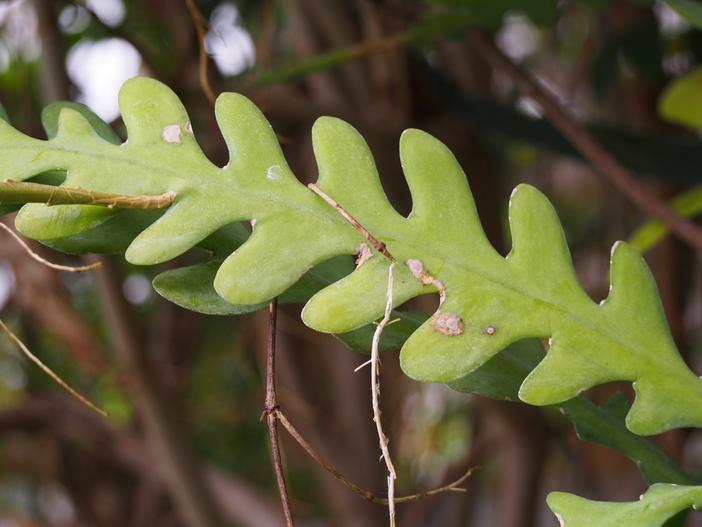Fishbone Cactus
(Disocactus anguliger)
Fishbone Cactus (Disocactus anguliger)
/
/

Agnieszka Kwiecień, Nova
CC BY-SA 4.0
Image By:
Agnieszka Kwiecień, Nova
Recorded By:
Copyright:
CC BY-SA 4.0
Copyright Notice:
Photo by: Agnieszka Kwiecień, Nova | License Type: CC BY-SA 4.0 | License URL: https://creativecommons.org/licenses/by-sa/4.0 | Uploader: Nova | Publisher: Wikipedia Commons
















Estimated Native Range
Summary
Disocactus anguliger, commonly known as the fishbone cactus or zig zag cactus, is an epiphytic cactus native to the tropical rainforests of Mexico. It is a perennial herb that thrives in the understory of these forests, where it grows on trees or rocks, absorbing moisture and nutrients from the air and rain. Disocactus anguliger typically reaches a length of 1 meter with its distinctive zigzag or fishbone-shaped stems. The white or pale yellow flowers are particularly showy due to their nocturnal blooming habit and strong, sweet scent, which attracts pollinators like bats and moths.
The fishbone cactus is favored for its unique foliage and fragrant, night-blooming flowers that appear in late autumn or early winter. It is often grown in hanging baskets or mounted on boards to mimic its natural epiphytic growing conditions. This cactus is relatively easy to maintain, requiring a compost rich in humus and consistent moisture during the summer growing season. While it tolerates a range of temperatures, it prefers to be kept at 16–25 °C (61–77 °F), with a slight drop to 10–15 °C (50–59 °F) for shorter periods to encourage blooming. It is best grown in semi-shade to replicate the dappled light of its rainforest habitat. Overwatering and poor drainage can lead to root rot, so it is crucial to ensure fast-draining soil and to reduce watering in the winter.CC BY-SA 4.0
The fishbone cactus is favored for its unique foliage and fragrant, night-blooming flowers that appear in late autumn or early winter. It is often grown in hanging baskets or mounted on boards to mimic its natural epiphytic growing conditions. This cactus is relatively easy to maintain, requiring a compost rich in humus and consistent moisture during the summer growing season. While it tolerates a range of temperatures, it prefers to be kept at 16–25 °C (61–77 °F), with a slight drop to 10–15 °C (50–59 °F) for shorter periods to encourage blooming. It is best grown in semi-shade to replicate the dappled light of its rainforest habitat. Overwatering and poor drainage can lead to root rot, so it is crucial to ensure fast-draining soil and to reduce watering in the winter.CC BY-SA 4.0
Plant Description
- Plant Type: Succulent
- Height: 2-2.5 feet
- Width: 2-2.5 feet
- Growth Rate: Moderate
- Flower Color: White
- Flowering Season: Fall, Winter
- Leaf Retention: Evergreen
Growth Requirements
- Sun: Part Shade
- Water: Medium
- Drainage: Fast
Common Uses
Drought Tolerant, Fragrant, Low Maintenance, Potted Plant, Showy Flowers
Natural Habitat
Native to the tropical rainforests of Mexico, thriving as an epiphyte in the understory
Other Names
Common Names: Zig Zag Cactus
Scientific Names: , Epiphyllum anguliger, Disocactus anguliger, Phyllocactus anguliger, Epiphyllum darrahii, Cereus mexicanus, Phyllocactus angularis, Phyllocactus darrahii, Phyllocactus mexicanus, Phyllocactus serratus,
GBIF Accepted Name: Disocactus anguliger (Lem.) M.Á.Cruz & S.Arias